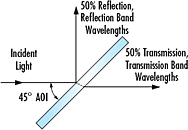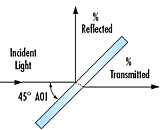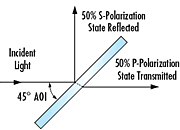
A plate beamsplitter is the most common type of beamsplitter. It features a thin glass substrate. The reflective coating is typically optimized at 45°, and an anti-reflection coating is commonly applied to the rear surface. Similar to cube beamsplitters, plate beamplitters also come in polarizing and non-polarizing types. Polarizing plate beamplitters split the input beam into two orthogonal components; P-polarized light is transmitted while S-polarized light is reflected 90° to it. Non-polarizing plate beamsplitters split the input beam into two orthogonal components; average, P-polarized and S-polarized states are transmitted and reflected equally. Dichroic plate beamsplitters reflect one portion of the spectrum while transmitting the other. They are ideal for splitting or combining specific wavelengths of light, depending upon the application setup. Polka-dot plate beamsplitters offer specific reflection/ transmission ratios. They have a constant reflection-to-transmission ratio over a large spectral range, making them ideal for use from UV to mid-IR. They are also not angle sensitive so they are great for splitting energy from a radiant light source. Pellicle beamsplitters offer specific reflection/ transmission ratios as well. Due to their ultra-thin nitrocellulose membrane construction, there are no ghost images from second surface reflections, no chromatic aberration with converging beams, and no change in optical path length. Elliptical plate beamsplitters maximize beamsplitter efficiency while maintaining required mounting space. When oriented at 45° they create a circular aperture equal to the diameter of the minor axis.
| Polarizing | Non-Polarizing | Lateral Displacement |
|---|---|---|
 |
 |
 |
or view regional numbers
QUOTE TOOL
enter stock numbers to begin
Copyright 2023 | Edmund Optics, Ltd Unit 1, Opus Avenue, Nether Poppleton, York, YO26 6BL, UK
California Consumer Privacy Act (CCPA): Do Not Sell or Share My Personal Information
California Transparency in Supply Chains Act